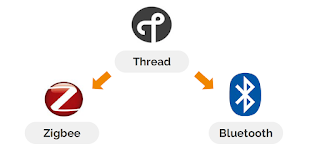Thread
Some time ago we asked our backers what you would like to
know more and quite a few have shown interest in Thread. This blog is thus
dedicated to Thread.
So we start with the question, what is Thread?
Well it is
something in the same category as Wi-Fi, Bluetooth, 3G, 4G etc that are now
house hold names and many people understand what they mean. Essentially, it is a wireless communication
method, but it has been specially designed from the ground up to make secure
and seamless communication between low power devices.
Many will ask why can’t we use Wi-Fi or Bluetooth. This is a very valid question especially because you can use Bluetooth between say your wireless headphone and your smart phone, or you can use Wi-Fi between you Laptop and your Printer although via a Wi-Fi router.
Many will ask why can’t we use Wi-Fi or Bluetooth. This is a very valid question especially because you can use Bluetooth between say your wireless headphone and your smart phone, or you can use Wi-Fi between you Laptop and your Printer although via a Wi-Fi router.

Bluetooth, unlike, Wi-Fi had its beginnings in low powered
devices like wireless mice and keyboards and then the latest Bluetooth Low
Energy, aka, BLE has gone one step further to even lower powered devices like
wearables example smart watches and health sensors etc. But Bluetooth has an
inherent problem that some people may not be aware of. The problem is it’s low
range and unavailability of meshing technology. To explain this further
Bluetooth low power slave devices like save power by turning off the radio
circuit when they do not expect to talk to the master device like a PC. This
means that this is more of a one sided communication and thus results in what
we call a star network. A network in which slave devices talk to one master
device only. This has a limitation on number of devices that can actively
connect to a master.
The problem with Bluetooth was first (commercially) tackled by the likes of ZigBee and Z-Wave. Both technologies introduced meshing, but specifically ZigBee can theoretically have hundreds of devices in a network that talk to each other and pass each others messages around the network thus forming what we call a mesh network.
ZigBee and Z-wave technology can be seen in several home
automation products that are on sale now a days. Products with these
technologies generally can be found in smart lighting, smart locks, some
security systems and also in some remote control applications. The biggest
market however for ZigBee has been smart energy and ZigBee has been used in
millions of smart meters around the world.
Bluetooth SIG (Special Interest Group) has introduced
Bluetooth Mesh technology, which is another competitor in this sector.
Bluetooth mesh works differently from Thread and ZigBee in some respects. For
example, for those familiar with routing protocols, BT Mesh uses network
flooding to transmit packets. This means that a message sent goes to all
devices. This is very useful in small home networks and is a special favourite
of smart light industry, however this means that the packet latency becomes a
problem with number of devices on a network and you cannot transfer large
amount of data over this network without completely starving it of bandwidth.
So what is special about Thread, and why do we need Thread
when we have ZigBee. The answer lies in the fact that ZigBee has been in
development since early 2000s and it has failed to capture the home automation
market. It has only risen to popularity in the last few years. ZigBee tried hard
during it’s existence to become a one-for-all protocol. Unfortunately, year
after year it failed to deliver intra-operability between manufacturers. So,
for example if you bought a Zigbee switch from one manufacturer and a ZigBee
light from another manufacturer, officially they should work seamlessly
together but in realty that rarely happened. Reasons was that the functionality
of the Gateway device had to be defined from start. A gateway must support a
light switch already to be able to work for it. Thus, a universal gateway that
supported all possible ZigBee devices didn’t exist.
Thread has gone back to basics and defined a protocol from
scratch and based it on the internet protocols we use on the daily basis, on
our computers, on our phone, on our tablets and even on our smart TVs.
The result is that Thread gateway is a much simpler device.
It does not need to know what kind of Thread device is being connected to it beforehand
and thus is much more universal. So much so that there is chance that soon
Thread gateways may be built in to home Wi-Fi routers as standard.
Thread then continues to make device connectivity simpler
and secure. The most common method to bring a Thread device onboard a gateway
is by scanning its QR code via a Smartphone app. The Smartphone app acts as a
security broker between the Thread gateway and the Thread joining device. All
this happen using security technologies that we use on the web and have been
tested and developed over many years. In a nut shell, Thread provides world
class security of data between devices.
Thread still provides meshing so there can be up to 250
devices on a Thread network. A recent comparison between home automation
protocols (ZigBee , Thread and BT Mesh) found Thread to be the best at routing
packets and lowest latency of messages. You should not have to wait 5 seconds
between pressing the switch and seeing the light turn on.
Thread also gets rid of single point of failure. For example,
in ZigBee there is only one Gateway and if it fails then the network connectivity
to internet fails. Also, you cannot commission new devices to the network
without a working gateway. Thread supports multiple Gateways and in a network
with more than one gateway, if one fails, another one automatically takes over
it’s responsibilities.
From a developer point of view Thread provides the simplest
way to create wireless mesh networked devices. As time goes on we will see more
and more thread related devices appear on the market. ZigBee alliance in
cooperation with Thread have developed the DotDot application layer that brings
many years of ZigBee learning to Thread. Although Thread is application layer agnostic,
but I believe overtime we should see more and more Thread devices working
together either though Cloud-to-Cloud integration or just talking to each other
on a local Thread network.
Thread, believe it or not, is the future of home automation IoT devices.
And with all the advantages it presents it may become the defacto for
Industrial IoT as well.


Comments
Post a Comment